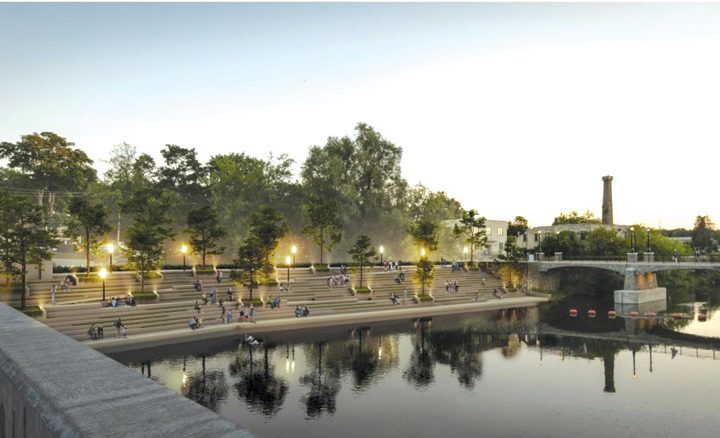GUELPH – Wellington County council wants more information before endorsing a funding application and partnership proposal with the Elora Mill, a subsidiary of Pearle Hospitality, to develop a new public space in downtown Elora.
The proposed Riverwalk project would be located in an undeveloped area along the south bank of the Grand River in Elora, between the Badley Bridge and Jack R. MacDonald Bridge.
The waterfront area is approximately two-thirds owned by the Elora Mill and one-third owned by the county, states a staff report from economic development director Crystal Ellis presented at the Oct. 28 meeting.
The Riverwalk is part of Pearle Hospitality’s Elora Mill South development, “which will expand the downtown core and includes plans for boutique services, shops, restaurants and creative spaces for artists,” the report states.
“The Riverwalk consists of concrete seating and ramped walkways, with lighting and landscaping that lead down to a waterfront boardwalk. It will be publicly accessible and AODA (Accessiblity for Ontarians with Disabilities Act) compliant. The GRCA has helped guide the design to ensure the sustainability of the ecosystem and the stability of the riverbank. The target completion date for the Riverwalk is end of 2022,” the report indicates.
Pearle Hospitality is asking the county to collaborate on a federal grant application, including making a financial commitment toward the $2.7-million Riverwalk project.
The company proposed costs be split between the Elora Mill, the county, a funding request to the federal government and a request to the Grand River Conservation Authority. The proposal calls for a county contribution of $915,000.
The county’s economic development committee supported a staff report recommending support for a funding application to the Federal Economic Development Agency for the Elora Mill Riverwalk Project and that the county consider contributing funding.
“This site would add to the Wellington County tourism portfolio that includes trails, heritage downtowns, farms, festivals and spectacular libraries,” states the report.
“Staff recommend we support this project in a financially responsible fashion.”
The report also notes the county “has traditionally taken the approach that as one community benefits from a new business, all communities benefit through increased taxes.”
In addition to development charges and job creation, once fully completed in 2030, the Elora South development would pay estimated annual property taxes of $1,871,581, from which $923,723 would be paid to the county specifically.
Councillor Campbell Cork questioned the contribution of tax dollars toward a private sector project.
“I’d like to be very clear that this Elora Riverwalk project looks like a terrific project,” said Cork.
“However, this is a private sector project. And we’re being involved solely because we own a small chunk of land adjacent to the proposal that I gather might be part of the proposal.”
He added, “If we go into this, we’re not only going to be contributing to the capital process, we’re going to be on the hook for operating … I think if we’re going to begin to get into this kind of an arrangement with the private sector, I think we’re going to be setting a precedent for every one of our municipalities who have waterfront or riverfront property. And there’s plenty of it.
“We don’t subsidize other such developments in this manner and, frankly, I see this as a Centre Wellington project and I think that I find it very telling that Centre Wellington is not one of the targets for funding by the developer.”
Councillor George Bridge, who chairs the economic development committee, said, “I don’t feel that this motion actually puts us in any kind of stress to do with any funding at this point in time.”
Bridge said the committee had simply asked the treasury and economic development departments “to look at any options that might be out there” such as Community Improvement Program funding “or some other programming that we have.
“I think we’re very early to be voting on turning down a very generic motion without more facts,” said Bridge.
Councillor Chris White agreed.
“We need some more information. You can’t deny that this is an absolute jewel in this community, and it’s a tourist attraction and all benefits of taxes come back to all of us,” said White.
However, he asked, “When you look at the specific project in isolation, if the county didn’t put the money in, would it not be funded?”
White continued, “So I absolutely support the idea that we look further into it and not just kill it out of the gate. We really need to know, more fulsomely what it is we’re talking about.”
Councillor Mary Lloyd reminded councillors the project includes public access to the Grand River and would be more easily done before the rest of the mill property development is finished.
“Keep in mind that they are also going to be doing a full access availability for the public as maintained in the agreements from the walking bridge across that property so that kayakers have access to whitewater rapids, so that the public can access that space,” Lloyd explained.
“We have a window of time prior to these builds happening, where this work can get in and be a lower-cost thing. If you go in afterwards, after all these big buildings are built, and you tried to put these things in, it can’t happen.”
Bridge stressed the action recommended by the committee did not commit the county to funding the project.
“We’re not making any decisions here other than staff go back to work on it,” he said.
Wellington Place administrator – museum, archives and economic development Jana Burns advised council the deadline for submitting the federal funding application is the end of the year and suggested staff could provide further information at the November economic development committee meeting.
Council agreed to receive the report as information and directed staff to pursue more information on the project and funding application.




